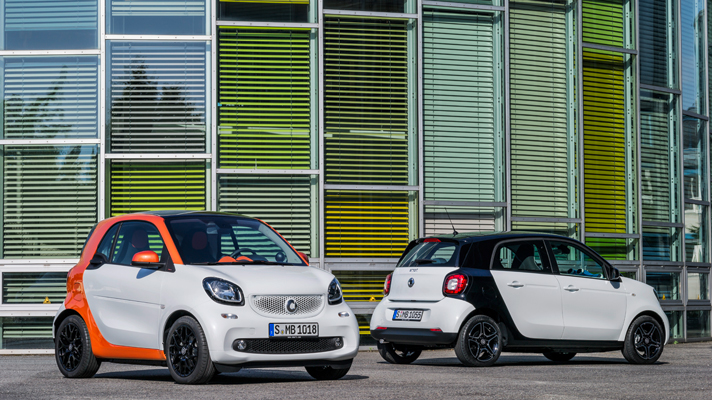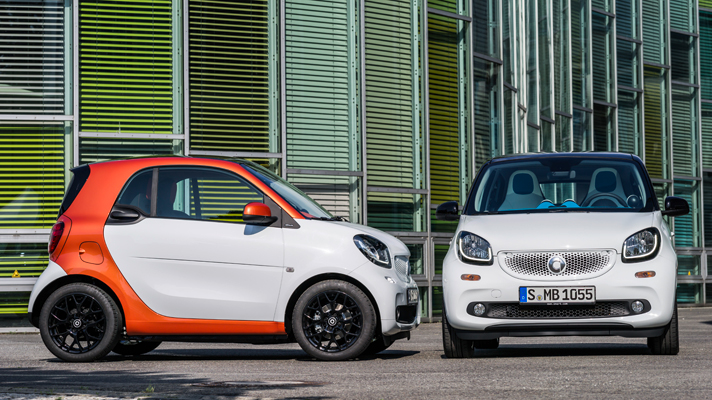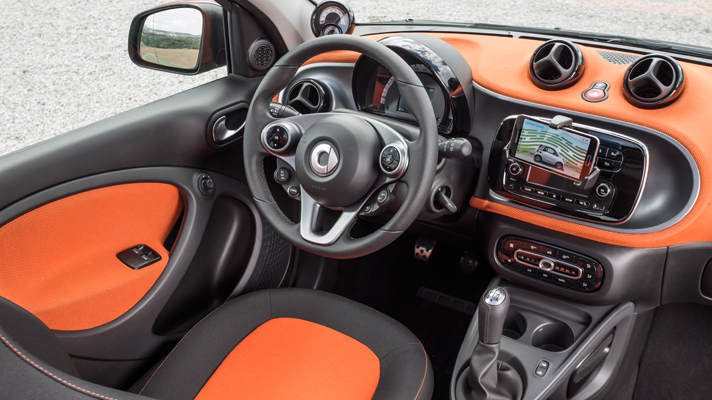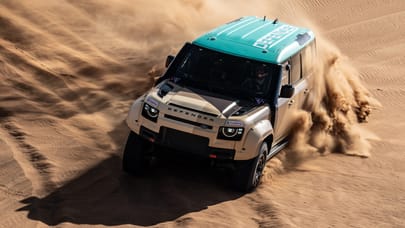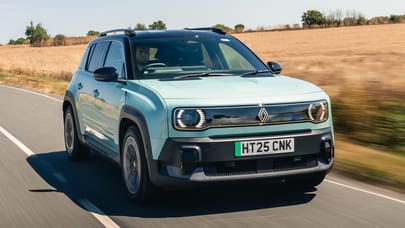
So, what’s next for Smart?
Stand by, all you dwellers in postcodes where prices are high and space short. This is the new Smart. Or rather these are the new Smarts. Because all at once we've got the new Fortwo and also its Forfour non-identical twin.
The Forfour is pretty much a stretched version of the two-seater, with extra doors. The two cars share their front and rear designs, the dash, rear-mounted powertrain and the suspension.
At the front we see a far more distinct step-front and a distinctly surprised-looking brow, instead of the old slope-fronted silhouette.
Two reasons. First, the designers wanted to move away from the one-box shape because MPVs are a bit old-hat these days. Second, a higher and softer bonnet is good for pedestrian protection. Yet critically, the Fortwo is the same length as before at 2.69m. So fly-parking is still very much on the cards.
The new car is a fair bit wider than the old, up by 10cm. The original Smart began life with the idea of fitting Japan's narrow Kei-car template. Then it flipped in a safety test so they moved the wheels out. The designers liked that wide-arched look, so they've retained it for this car, which has a wider track. In the centre of the car the body swells out to give more width for the passengers. It tapers behind so it still has the broad arches. Also, that body taper cuts drag.
At the back, the Fortwo retains the split tailgate, as it means you can get to the boot even when the car's jammed up against something. The Forfour has a normal single-piece tailgate.
It might have a loyal following, but Smart has never made any money. It's avoided euthanasia by co-operating with Renault. The mechanical bones of and inner body skeleton of the Forfour have been lent to the new Twingo, and they'll both be made at a Renault factory in Slovenia.
But the Fortwo remains a Smart solo album: there'll be no Renault two-seater, and the Fortwo is made at Smart's usual plant in Hambach, eastern France.
The engines still sit under the boot floor. They're designed by Renault (the old ones were from Mitsubishi). They're adapted from the three-cylinder in the Clio, but use lots of new parts so they can lie at 49 degrees and fit under the boot floor. They make 71 or a turbo'd 90bhp.
And some very very good news. The old Wobble-O-Matic™ single-clutch sequential transmission has been finally been asked to spend more time with its family. In its place comes a proper twin-clutch auto. Or there's a five-speed manual, something the Fortwo never offered.
Top Gear
Newsletter
Thank you for subscribing to our newsletter. Look out for your regular round-up of news, reviews and offers in your inbox.
Get all the latest news, reviews and exclusives, direct to your inbox.
So no longer will you be nodding your head at every gearshift. The chassis is supposed to be comfier than before, too. At the front the MacPherson design now has a rear wishbone mount that's longtuinally soft. This lets the wheel glance back when it hits a bump, so transmitting less vibration to he body. Common practice in many cars, but new to Smart. At the back there's still a de Dion axle, but the parts are all new.
Smart engineers say the Renault uses the same basic chassis parts, but has its own unique tuning of springs and dampers. We asked the chassis man how different they feel. His answer in full: "I've never driven a Renault”.
Safety goes up. The body is made out of better grades of steel, and it's been crash-tested in a head-on against an S-Class. The airbag count is five, and front collision radar is optional. Because of their different weights, the two cars have different crash structures (the Forfour's nose is slightly longer) but the designers aimed to make them look the same.
The dash includes options for bring your own media: your phone clips in and supplies the nav (with offline maps, so you thankfully don't rely on flaky mobile 3G), media, phone and apps.
It's not cheap, even though it'll be barely dearer than it is now. That means a likely £11k upwards. The premium for the Forfour is likely to be small, at little over £500. UK sales start in December.
Even at those comparatively high prices, the Smart division has always lost significant money for Mercedes. Hence the joint venture with Renault, to provide three cars off the one platform (and more later – a cabrio and a jacked-up quasi-crossover.) Top Gear asked Dr Dieter Zetsche, Mercedes boss, if this one will actually make money. "Yes, straight after ramp-up," he said.
And critically, if not for the joint venture, would there have been this new Smart at all? "Likely not." They would have killed it.
So, commenters, will it sell? Oh, and does the Forfour look wrong, when the Twingo looks so darned right?
Trending this week
- Car Review
BMW 1 Series
- Top Gear's Top 9
Nine dreadful bits of 'homeware' made by carmakers




